Water is the source of life for all living organisms. If oxygen (air) is the main component that is necessary for all living things, then water takes second place after oxygen in the life of living organisms. Once in the human body, it is responsible for the basic functions of our body.
Man, as a result of his activities, disrupts natural processes, while polluting fresh water bodies, rivers and seas. The lack of fresh water, the amount of which is only 2.7% of the total volume of water on our planet, is still a global problem for the entire earth planet. And this amount of clean water is polluted with harmful substances such as oil products, nitrogen groups, sulfates, phosphates, mineral fertilizers and pesticides, etc. Pollution of natural and anthropogenic impacts lead to such consequences [1].
Kyrgyzstan is a rich country in terms of clean water resources in Central Asia. But at the moment there is an increase from the norm of water pollution. Here are some of the main reasons for the deterioration of water quality in Kyrgyzstan:
• Mineralization;
• Discharge of untreated industrial and domestic waste water;
• Migration of nitrogen and phosphate fertilizers;
• Failure to comply with the filtration reliability of industrial facilities [2].
In this study, we got acquainted with pesticides, sources of pesticides, what they are used for and how they affect health when they enter the human body.
Since in agriculture various types of pesticides are used to control weeds and insect pests (herbicides, insecticides, fungicides, nematicides, etc.), they enter the soil, water, and from the soil and water into the body of animals, plants, then into food products (milk, meat, vegetables, etc.) [3].
For each pesticide MPC is set – maximum allowable concentration. If the content of pesticides in products is more than the permissible norm, this leads to various human diseases. For example, polychloropolycyclic compounds, if even a small amount of PCPC enter the body, then a person suffers from cancer, and one drop of tetraethyl pyrophosphate on human skin leads to instant death.
In the composition of pesticides, if there are organophosphorus substances, then at the beginning a person is seized by a convulsion, then paralysis occurs and finally death [4].
Thus, 1% of all soil pollutants are pesticides.
Based on this, we set a goal to determine the content of pesticides in the waters of the rivers of the Chui valley: Alamedin, Ala-Archa, Chui.
We used gas-liquid chromatography to determine pesticides. This is a modern, fast, high-precision, convenient method and it is possible to determine several pesticides at once in a very minimal content (ppm) [5].
Experimental data on determining the concentrations of pesticides in the waters of the rivers of the Chui valley: Alamedin, Ala-Archa, Chui are given in tables 1-3.
Table 1
The content of pesticides in the w≤0,001 mg/dm3ater of the Alamedin River
|
№ |
Name of pesticides |
Sample points |
unit |
Maximum permissible concentration |
||
|
Ала-1 |
Ала-2 |
Ала-3 |
||||
|
1 |
α-HCCH |
0,0001 |
0,0015 |
0,0002 |
mg/dm3 |
≤0,001 mg/dm3 |
|
2 |
β-HCCH |
0,0015 |
0,0002 |
0,0015 |
mg/dm3 |
≤0,001 mg/dm3 |
|
3 |
γ-HCCH |
0,001 |
0,0015 |
0,0002 |
mg/dm3 |
≤0,001 mg/dm3 |
|
4 |
4,4 DDE |
0,0005 |
0,0025 |
0,0030 |
mg/dm3 |
≤0,001 mg/dm3 |
|
5 |
4,4 DDD |
0,0025 |
0,0001 |
0,0005 |
mg/dm3 |
≤0,001 mg/dm3 |
|
6 |
4,4 DDT |
0,0001 |
0,0002 |
0,0007 |
mg/dm3 |
≤0,001 mg/dm3 |
|
7 |
ALDRIN |
0,002 |
0,0015 |
0,001 |
mg/dm3 |
≤0,001 mg/dm3 |
|
8 |
DIELDRIN |
0,0003 |
0,005 |
0,0001 |
mg/dm3 |
≤0,001 mg/dm3 |
|
9 |
HEPTACHLOR |
0,0005 |
0,0001 |
0,0004 |
mg/dm3 |
≤0,001 mg/dm3 |
According to these tables, we built figures 1; 2; 3 and calibration graphs 1-3.
As can be seen from Table 1, pesticides α-HCCH (0.0001; 0.0002 mg/dm3); 4.4 DDT (0.0001; 0.0007); Dieldrin (0.0003; 0.0001); heptachlor (0.0005; 0.0004 mg/dm3); in the water of the Alamedin River is below the maximum permissible concentration. Pesticides ß-HCCH (0.0015 mg/dm3); Aldrin (0.002; 0.001) slightly exceed the norm.
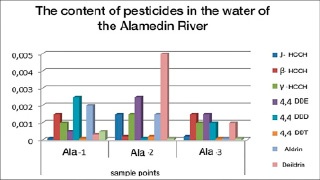
Fig. 1
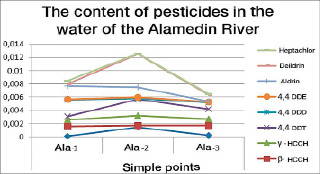
Calibration curve 1
Using tabular data, we have built figure 1 and calibration graph 1 and the above conclusion is confirmed by figure 1 and calibration graph 1.
Experimental data obtained by gas-liquid chromatography of the water of the Ala-Archa.
River are shown in Table 2.
Table 2
The content of pesticides in the water of the Ala-Archa River
|
№ |
Name of pesticide |
Sample points |
unit |
Maximum permissible concentration |
||
|
А-Аr-1 |
А-Аr-2 |
А-Аr-3 |
||||
|
1 |
α-HCCH |
0,0001 |
0,001 |
0,0002 |
mg/dm3 |
≤0,001 mg/dm3 |
|
2 |
β-HCCH |
0,001 |
0,0001 |
0,0015 |
mg/dm3 |
≤0,001 mg/dm3 |
|
3 |
γ-HCCH |
0,0015 |
0,0001 |
0,001 |
mg/dm3 |
≤0,001 mg/dm3 |
|
4 |
4,4 DDE |
0,0001 |
0,001 |
0,0015 |
mg/dm3 |
≤0,001 mg/dm3 |
|
5 |
4,4 DDD |
0,0015 |
0,0001 |
0,001 |
mg/dm3 |
≤0,001 mg/dm3 |
|
6 |
4,4 DDT |
0,001 |
0,0015 |
0,0001 |
mg/dm3 |
≤0,001 mg/dm3 |
|
7 |
ALDRIN |
0,0015 |
0,001 |
0,0001 |
mg/dm3 |
≤0,001 mg/dm3 |
|
8 |
DIELDRIN |
0,0001 |
0,0015 |
0,001 |
mg/dm3 |
≤0,001 mg/dm3 |
|
9 |
HEPTACHLOR |
0,0015 |
0,001 |
0,0001 |
mg/dm3 |
≤0,001 mg/dm3 |
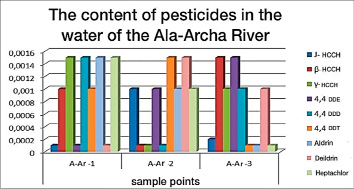
Fig. 2
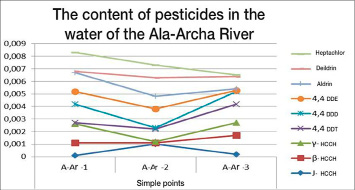
Calibration curve 2
Table 3
The content of pesticides in the water of the Chui River
|
№ |
Name of pesticides |
Sample points |
unit |
Maximum permissible concentration |
||
|
Чуй-1 |
Чуй -2 |
Чуй -3 |
||||
|
1 |
α-HCCH |
0,001 |
0,0015 |
0,0002 |
mg/dm3 |
≤0,001 mg/dm3 |
|
2 |
β-HCCH |
0,0002 |
0,0015 |
0,0002 |
mg/dm3 |
≤0,001 mg/dm3 |
|
3 |
γ-HCCH |
0,0015 |
0,0015 |
0,0015 |
mg/dm3 |
≤0,001 mg/dm3 |
|
4 |
4,4 DDE |
0,0003 |
0,0025 |
0,0035 |
mg/dm3 |
≤0,001 mg/dm3 |
|
5 |
4,4 DDD |
0,001 |
0,0015 |
0,0002 |
mg/dm3 |
≤0,001 mg/dm3 |
|
6 |
4,4 DDT |
0,0015 |
0,001 |
0,0001 |
mg/dm3 |
≤0,001 mg/dm3 |
|
7 |
ALDRIN |
0,002 |
0,0025 |
0,001 |
mg/dm3 |
≤0,001 mg/dm3 |
|
8 |
DIELDRIN |
0,0015 |
0,0002 |
0,0001 |
mg/dm3 |
≤0,001 mg/dm3 |
|
9 |
heptachlor |
0,0002 |
0,0001 |
0,0002 |
mg/dm3 |
≤0,001 mg/dm3 |
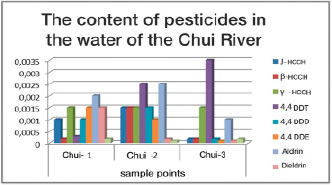
Fig. 3
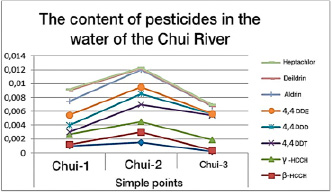
Calibration curve 3
Analyzes show that the pesticide α-HCCH (0.0001; 0.0002 mg/dm3) in the water of the Ala-Archa River contains less than the maximum allowable concentration. The remaining pesticides (0.0015 mg/dm3) exceed MPC in negligibly small amounts.
According to table 2, we have built figure 2 and calibration graph 2, where it can be seen that the concentrations of the corresponding 8 pesticides are equal to or slightly more than the maximum allowable concentration.
Based on Table 3, figure 3 and Calibration Chart 3, we came to the conclusion that in the water of the Chui River, pesticides α-HCCH, 4.4 DDE, Aldrin slightly exceed the maximum allowable concentration, other pesticides are within the normal range or below the norm.
Based on table 3, figure 3 and calibration chart 3, we came to the conclusion that in the water of the Chui River, pesticides α-HCCH, 4.4 DDE, Aldrin slightly exceed the maximum allowable concentration, other pesticides are within the normal range or below the norm. Figure 3 and calibration curve 3 built according to the data of table 3 confirm the above conclusion.
In carrying out this research work, we determined the concentrations of pesticides in the waters of the rivers of the Chui valley: Alamedin, Ala-Archa, Chui. Experimental data are given by us in tables 1, 2, 3. According to these tables, we built figures 1, 2, 3 and calibration curves 1, 2, 3. The analyzes were carried out by gas-liquid chromatography, which is a fast, highly sensitive, accurate method, also detecting very low concentrations (ppm).
Determining the concentrations of pesticides (9) in the waters of the Alamedin, Ala-Archa, Chui rivers, they came to the conclusion that in these waters (in winter) the content of pesticides is within or below the maximum allowable concentration (MAC).

